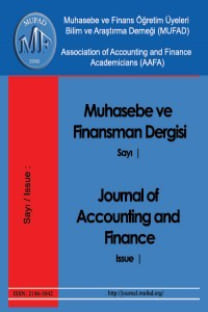Lunar cycle effect and an application in Ise
Lunar cycle effect and an application in Ise
___
- Campbell, Davis E. Beets, John L. (1978), Lunacy and The Moon, Psychological Bulletin, Vol 85 , No. 5, pp. 1123 1129.
- Dichev, Ilia D. Janes, Troy D. (2003), Lunar Cycle Effects in Stock Returns, The Journal of Private Equity, Vol. 6, No. 4, pp. 8- 29.
- Dodd, Olga Gakhovich, Alex (2011), The Holiday Effect in Central and Eastern European Financial Markets, Investment Management and Financial Innovations, Vol. 8, No. 4, pp. 29- 35.
- Dowling, Michael Lucey, Brian M . (2008), Mood and UK Equity Pricing, Applied Financial Economics L etters, Vol. 4, pp. 233 - 240.
- Farah, Raed Michel (2008), Investor Behavior and The IPO Effect in the GCC Stock Markets, American University of Beirut, pp. 1 56.
- Herbst, Anthony F. (2007), Lunacy in the Stock Market What is the E vidence?, Journal of Bioeconomics, Vol. 9, pp. 1 18.
- Kaustia, Markku - Rantapuska, Elias (2012), Does M ood Affect T rading B ehavior?, Aalto University, Working Paper,
- Keef, Stephen P. - Khaled, Mohammed S. (2011), Are I nvestors M oonstruck? Further I nternational E vidence on L unar P hases and S tock Returns , Journal of Empirical F inance, Vol. 18, pp. 56- 63 .
- Krivelyova, Anna Robotti, Cesare (2003), Playing The Field: Geomagnetic Storms and the Stock Market, Federal Reserve Bank of Atlanta, Working Paper, pp. 1 51.
- Liu, Shu- Ing Tseng, Jauling (2009), A Bayesian Analysis of Lunar Effects on Stock Returns, The IUP Journal of Behavioral Finance, Vol. 6, No 3&4, pp. 67- 83.
- Lucey, Brian M. (2010), Lunar Seasonality in Precious Metal Returns?, Applied Economics Letters, Vol. 17, pp. 835- 838.
- Loughran, Tim Schultz, Paul (2004), Wheather, Stock Returns, and the Impact of Localized Trading Behavior, Journal of Financial and Quantitative Analysis, No. 39, pp. 343 364.
- Mhanna, Gabriella Toufic (2008), The Holy Day Effect: Evidence From GCC Market, American University of Beirut, pp. 1 55.
- Noyan, M. Ayşın, Elbi, Hayriye Korukoğlu, Serdar (2000), Mevsimsel Gidiş Değerlendirme Formu (MGDF): Güvenilirlik Araştırması, Anadolu Psikiyatri Dergisi, Cilt 1 , Sayı 2, ss . 69- 77.
- Scuffy, Crystal (2011), Belief in Lunar Effects, University of Minnesota Duluth, Unpublished Master Thesis, pp. 1 53.
- Sewell, Martin (2010), Behavioural Finance, Working Paper, University of Cambridge, pp. 1 13.
- Wang, Yi- Hsien, Lin, Wei- Ling Chen, Wei- Ling (2010), Does Lunar Cycle Effect Exist? Lunar Phases and Stock Return Volatilities, African Journal of Business Management, Vol. 4, No. 18, pp. 3892- 3897.
- Yuan, Kathy, Zheng, Lu Zhu, Qiaoqiao (2006), Are Investors Moonstruck? Lunar Phases and Stock Returns, Journal of Empirical F inance, Vol. 13 , No.1 , pp. 1 23.
- Zhu, Qiaoqiao (2009), , Three Essays on International Finance and International Capital M arkets , The University of Michigan, Proquest Dissertations and Theses , pp. 1 - 195 .
- ISSN: 2146-3042
- Yayın Aralığı: 4
- Başlangıç: 2005
- Yayıncı: Muhasebe ve Finansman Öğretim Üyeleri Derneği (MUFAD)
İstanbul menkul kıymetler borsası'nda işlem hacmi ile getiri ilişkisi
Halime NALIN TEMEL, Sevinç GÜLER
A different approach to prevent fraud and embezzlement in firms: Forensic accounting
Umut Tolga GÜMÜŞ, Ahmet COŞKUN, Selim BEKÇİOĞLU
